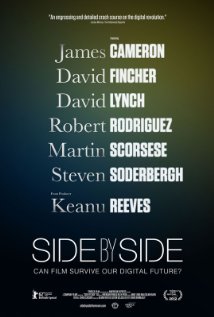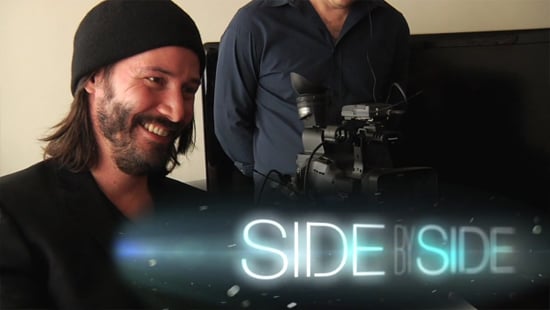Side By Side
Written by Christopher Kenneally
Directed by Christopher Kenneally
USA, 2012
A reasonably comprehensive primer on the rise of digital film and its implications on every facet of filmmaking, exhibition, and conservation, Side by Side manages to corral enough of the film world’s most outspoken filmmakers, as well as a less-familiar but equally influential collection of editors, DPs, colorists, effects supervisors, and industry types, that its attempt to summarize such a massive issue mostly holds together while only occasionally feeling like an infomercial for contemporary moviegoing.
Buoyed by a balance of film cips, archival footage, and new interviews, producer and host Keanu Reeves eases into the specifics of photochemical film shooting and exhibition, carefully laying out the joys and difficulties of a science that remained more or less unchanged for a century, before chronicling the evolution of digital film, from its invention to its first uses in serious filmmaking. Among the film’s greatest virtues is its inclusiveness, though some of that is by necessity: as the Dogme 95 crew were perhaps the key popularizing force for digital filmmaking in the late 90s, the likes of The Celebration, The Idiots, and Julien Donkey-Boy are excerpted between the likes of Avatar and Clash of the Titans. (von Trier himself pops up, seeming to regret the manner in which digital film grew safer and more sophisticated over time, even while he continues to use the technology.) Arthouse provocateurs and blockbuster scientists get more or less equal credit here for driving technological innovation.

While the great majority of the players are unequivocally excited about the new tech and its possibilities – David Fincher, Robert Rodriguez, and Steven Soderbergh are especially forceful in their invective against the old guard – there remain a few who insist that digital, as a visual medium, still can’t match film, particularly cinematographer Dick Pope, as well as Christopher Nolan and his frequent DP Wally Pfister (who at least allows that digital projection is by now up to snuff). Ultimately, however, Side by Side seems to land comfortably on the notion, espoused by George Lucas and James Cameron, that while photochemical exhibition and production had a century to be perfected, digital tech is still young, and will iron out any and all kinks in time. (Thankfully, the film finds time to examine the difficulties of digital archiving, noting that celluloid is still by far the better option for long-term conservation.)
Whether or not the viewer agrees with that assessment, Side by Side also dutifully takes a look at the fringe effects and benefits of the digital revolution, particularly its democratizing effect on filmmaking (particularly espoused by Lena Dunham, who speaks of the shattered myth of the filmmaker as the hallowed profession of the technically gifted) and the effect of shifting from dailies to “immediatelies” (as Reeves calls them). While the closing minutes err a little on the cine-mushy side, Side by Side is a fine portrait of an industry in flux.
Simon Howell


